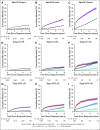Cause-Specific Mortality Following Initial Chemotherapy in a Population-Based Cohort of Patients With Classical Hodgkin Lymphoma, 2000-2016
- PMID: 32946352
- PMCID: PMC7723686
- DOI: 10.1200/JCO.20.00264
Cause-Specific Mortality Following Initial Chemotherapy in a Population-Based Cohort of Patients With Classical Hodgkin Lymphoma, 2000-2016
Abstract
Purpose: Mortality for patients with classical Hodgkin lymphoma (cHL) treated during an era characterized in the United States by widespread use of doxorubicin, bleomycin, vinblastine, and dacarbazine and diminishing use of radiotherapy is not well understood.
Patients and methods: We identified 20,007 individuals diagnosed with stage I/II (early) or III/IV (advanced) cHL between age 20 and 74 years treated with initial chemotherapy in US population-based cancer registries during 2000-2015 (follow-up through 2016). We used standardized mortality ratios (SMRs) to compare cause-specific relative mortality risk following cHL to that expected in the general population and estimated excess absolute risks (EARs; per 10,000 patient-years) to quantify disease-specific death burden.
Results: We identified 3,380 deaths in the cHL cohort, including 1,321 (39%) not attributed to lymphoma. Overall, noncancer SMRs were increased 2.4-fold (95% CI, 2.2 to 2.6; observed, 559; EAR, 61.6) and 1.6-fold (95% CI, 1.4 to 1.7; observed, 473; EAR, 18.2) for advanced- and early-stage cHL, respectively, compared with the general US population. SMRs and EARs differed substantially by cause of death and cHL stage. Among the highest EARs for noncancer causes of death were those for heart disease (EAR, 15.1; SMR, 2.1), infections (EAR, 10.6; SMR, 3.9), interstitial lung disease (ILD; EAR, 9.7; SMR, 22.1), and adverse events (AEs) related to medications/drugs (EAR, 7.4; SMR, 5.0) after advanced-stage cHL and heart disease (EAR, 6.6; SMR, 1.7), ILD (EAR, 3.7; SMR, 13.1), and infections (EAR, 3.1; SMR, 2.2) after early-stage cHL. Strikingly elevated SMRs for ILD, infections, and AEs were observed < 1 year after cHL. Individuals age 60-74 years with advanced-stage cHL experienced a disproportionate excess of deaths as a result of heart disease, ILD, infections, AEs, and solid tumors.
Conclusion: Despite evolving cHL treatment approaches, patients continue to face increased nonlymphoma mortality risks from multiple, potentially preventable causes. Surveillance, early interventions, and cHL treatment refinements may favorably affect patient longevity, particularly among high-risk subgroups.
Figures


Comment in
-
Continuum of Care for Hodgkin Lymphoma: Impact of Modern Therapy on Postacute Morbidity and Mortality.J Clin Oncol. 2020 Dec 10;38(35):4131-4134. doi: 10.1200/JCO.20.02668. Epub 2020 Oct 8. J Clin Oncol. 2020. PMID: 33030980 Free PMC article. No abstract available.
Similar articles
-
Cancer-specific mortality, cure fraction, and noncancer causes of death among diffuse large B-cell lymphoma patients in the immunochemotherapy era.Cancer. 2017 Sep 1;123(17):3326-3334. doi: 10.1002/cncr.30739. Epub 2017 May 2. Cancer. 2017. PMID: 28464214
-
Noncancer causes of death in survivors of testicular cancer.J Natl Cancer Inst. 2007 Apr 4;99(7):533-44. doi: 10.1093/jnci/djk111. J Natl Cancer Inst. 2007. PMID: 17405998
-
Evaluation of the Risk of Relapse in Classical Hodgkin Lymphoma at Event-Free Survival Time Points and Survival Comparison With the General Population in British Columbia.J Clin Oncol. 2016 Jul 20;34(21):2493-500. doi: 10.1200/JCO.2015.65.4194. Epub 2016 Jun 6. J Clin Oncol. 2016. PMID: 27269949
-
[SENTIERI - Epidemiological Study of Residents in National Priority Contaminated Sites. Sixth Report].Epidemiol Prev. 2023 Jan-Apr;47(1-2 Suppl 1):1-286. doi: 10.19191/EP23.1-2-S1.003. Epidemiol Prev. 2023. PMID: 36825373 Italian.
-
Cancer of the Nasal Cavity, Middle Ear and Accessory Sinuses - 15 Year Comparative Survival and Mortality Analysis by Age, Sex, Race, Stage, Grade, Cohort Entry Time-Period, Disease Duration and Topographic Primary Sites: A Systematic Review of 13,404 Cases for Diagnosis Years 2000-2017: (NCI SEER*Stat 8.3.8).J Insur Med. 2024 Jul 1;51(2):77-91. doi: 10.17849/insm-51-2-77-91.1. J Insur Med. 2024. PMID: 39266003
Cited by
-
Impact of Preexisting Heart Failure on Treatment and Outcomes in Older Patients With Hodgkin Lymphoma.JACC CardioOncol. 2024 Apr 16;6(2):200-213. doi: 10.1016/j.jaccao.2024.02.003. eCollection 2024 Apr. JACC CardioOncol. 2024. PMID: 38774008 Free PMC article.
-
Major Adverse Cardiovascular Events and Cause-Specific Mortality After Hospitalisation in COPD.Int J Chron Obstruct Pulmon Dis. 2025 Jul 19;20:2549-2560. doi: 10.2147/COPD.S529171. eCollection 2025. Int J Chron Obstruct Pulmon Dis. 2025. PMID: 40703224 Free PMC article.
-
Hodgkin lymphoma treatment for older persons in the modern era.Hematology Am Soc Hematol Educ Program. 2023 Dec 8;2023(1):483-499. doi: 10.1182/hematology.2023000449. Hematology Am Soc Hematol Educ Program. 2023. PMID: 38066840 Free PMC article.
-
Are we ignoring sex differences in haematological malignancies? A call for improved reporting.Br J Haematol. 2025 May;206(5):1315-1329. doi: 10.1111/bjh.20044. Epub 2025 Mar 23. Br J Haematol. 2025. PMID: 40123129 Free PMC article. Review.
-
Quantitative PET-based biomarkers in lymphoma: getting ready for primetime.Nat Rev Clin Oncol. 2023 Sep;20(9):640-657. doi: 10.1038/s41571-023-00799-2. Epub 2023 Jul 17. Nat Rev Clin Oncol. 2023. PMID: 37460635 Review.
References
-
- Aleman BM, van den Belt-Dusebout AW, Klokman WJ, et al. Long-term cause-specific mortality of patients treated for Hodgkin’s disease. J Clin Oncol. 2003;21:3431–3439. - PubMed
-
- Bhuller KS, Zhang Y, Li D, et al. Late mortality, secondary malignancy and hospitalisation in teenage and young adult survivors of Hodgkin lymphoma: Report of the Childhood/Adolescent/Young Adult Cancer Survivors Research Program and the BC Cancer Agency Centre for Lymphoid Cancer. Br J Haematol. 2016;172:757–768. - PubMed
-
- Kero AE, Järvelä LS, Arola M, et al. Late mortality among 5-year survivors of early onset cancer: A population-based register study. Int J Cancer. 2015;136:1655–1664. - PubMed
-
- Ng AK, Bernardo MP, Weller E, et al. Long-term survival and competing causes of death in patients with early-stage Hodgkin’s disease treated at age 50 or younger. J Clin Oncol. 2002;20:2101–2108. - PubMed
Publication types
MeSH terms
Grants and funding
LinkOut - more resources
Full Text Sources
Medical

